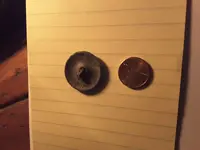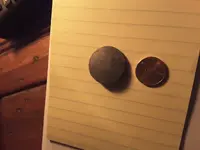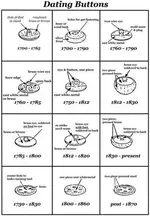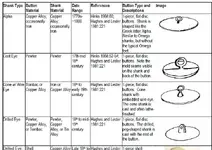You are using an out of date browser. It may not display this or other websites correctly.
You should upgrade or use an alternative browser.
You should upgrade or use an alternative browser.
Button - this much i know
- Thread starter thedukeofdelaware
- Start date
Looks like a colonial flat button. After about 1800 the style was to put a backmark on them, it was standard within a decade of then.
Upvote
0
TheCannonballGuy
Gold Member
- Joined
- Feb 24, 2006
- Messages
- 6,607
- Reaction score
- 13,455
- Golden Thread
- 0
- Location
- Occupied CSA (Richmond VA)
- Detector(s) used
- White's 6000, Nautilus DMC-1, Minelab
- Primary Interest:
- Relic Hunting
It appears to be a White Tombac 1-piece button with a "spun back" -- meaning, the button was placed in a lathe which spun the button while a lathing tool trimmed down the back to a smooth surface, often leaving tiny concentric rings showing on the back. You'll see one of the type you found in the two button-dating charts attached below. One chart says it is from 1760 to 1785. The other says simply "18th to early-19th century." (Meaning, 1700s to early-1800s.) In view of the massive quantities dug in Virginia and other east-coast states, I believe there's too many to have been made only in a 25-year span. So I'd date your button as being from sometime between the mid-1700s and about 1810, when "ornate" goldplated brass 1-piece flatbuttons became more popular than these plain-front buttons..
By the way... White Tombac is a dull silver-grey colored metal. It differs from regular Tombac (an alloy containing about 85% copper with 15% zinc) by having a small amount of the metal Arsenic added into the alloy while molten, which changes the metal's color from golden to silvery-grey.
By the way... White Tombac is a dull silver-grey colored metal. It differs from regular Tombac (an alloy containing about 85% copper with 15% zinc) by having a small amount of the metal Arsenic added into the alloy while molten, which changes the metal's color from golden to silvery-grey.
Attachments
Last edited:
Upvote
0
dts52
Bronze Member
It appears to be a White Tombac 1-piece button with a "spun back" -- meaning, the button was placed in a lathe which spun the button while a lathing tool trimmed down the back to a smooth surface, often leaving tiny concentric rings showing on the back. You'll see one of the type you found in the two button-dating charts attached below. One chart says it is from 1760 to 1785. The other says simply "18th to early-19th century." (Meaning, 1700s to early-1800s.) In view of the massive quantities dug in Virginia and other east-coast states, I believe there's too many to have been made only in a 25-year span. So I'd date your button as being from sometime between the mid-1700s and about 1810, when "ornate" goldplated brass 1-piece flatbuttons became more popular than these plain-front buttons..
By the way... White Tombac is a dull silver-grey colored metal. It differs from regular Tombac (an alloy containing about 85% copper with 15% zinc) by having a small amount of the metal Arsenic added into the alloy while molten, which changes the metal's color from golden to silvery-grey.
Thanks for the great info.
HH
dts
Upvote
0
Similar threads
- Replies
- 3
- Views
- 187
Users who are viewing this thread
Total: 1 (members: 0, guests: 1)







